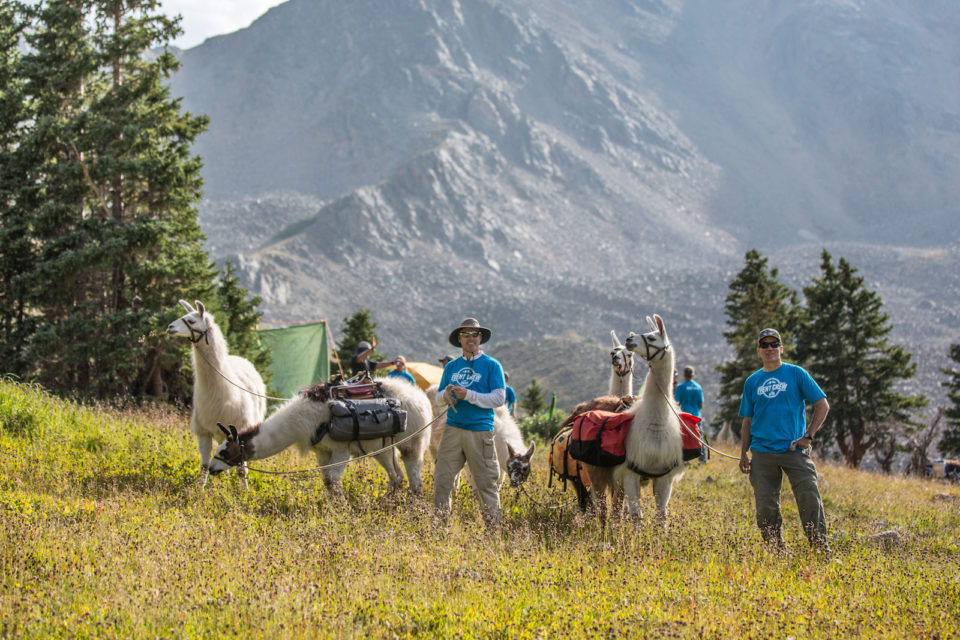The Local newsletter is your free, daily guide to life in Colorado. For locals, by locals. Sign up today!
This weekend, about 600 fearless runners will gather in Leadville for one of the most challenging and extreme races in the country. For 100 miles and 30 hours, Leadville 100 competitors brave heat, cold, rough terrain, and altitudes of 9,000 to 11,000 feet, supported by more than 400 volunteers at six aid stations throughout the course.
They are also supported by a hardy herd of 28 llamas. That’s right: Each year for the past 15 years, this special four-legged crew (along with their bipedal colleagues, of course) ascends more than 3,000 feet to Hope Pass—the highest pass of the race—in order to bring much-needed supplies to wearied runners.
That's only $1 per issue!
The llamas belong to Strasburg resident Gary Carlson, team captain and coordinator for the Hope Pass aid station. He’s been bringing his llamas along since a friend first roped him into volunteering in 2003. The station, which is inaccessible by vehicle, is stocked each year with more than 3,000 pounds of gear and food. Somehow, those supplies need to travel up the mountain and, says Carlson, llamas were the natural choice. Many Rocky Mountain residents like himself maintain herds, and they are easier to work with than horses.
“They are the engine that makes everything go,” says Richard Naprstek, the race’s volunteer coordinator, of the llamas at Hope Pass. “They are integral for the entire race.”
Over the course of the race, four of the fittest llamas shuttle 700 gallons of chlorinated water to the athletes, who at Hope Pass are one aid station away from the turnaround point. Volunteers act as cheerleaders, filter the water, and help distribute nourishment—from electrolytes to ramen.
Vicky Foster, the self-declared “best ramen cook that’s ever been at Hope Pass,” says the crew there is special. Foster, who no longer makes the journey and instead provides support at base camp, was part of the first Hope Pass crew 30 years ago. Originally the volunteers were a renegade group who lent a hand after learning the Pass was an especially dangerous point of the race. Now an official aid station, the team still retains a renegade spirit. “We are a pretty independent and hardworking group,” Foster says. They even have a name: the Hopeless Crew.
The team has played host to volunteers from Arkansas to Australia, including a select group of Golden High School students who also pitch in on the aid efforts. It’s not just the makeup of the group that makes it famous among race coordinators and runners. According to Naprstek, exposure to the elements—and the fact that volunteers must cover nearly 9 miles of trail just to get to the station—means that those at Hope Pass are especially dedicated.
Carlson says he’s returned to volunteer for the Leadville 100 each year out of admiration of the athletes. “It just blew me away that these people are running 100 miles like that. They just ran from [Leadville] to here, and they’ve got to run back. It’s just mind-blowing.” Hope Pass, meanwhile, has a draw of its own. Above the tree line, its remote location offers a tranquil sense of beauty. Carlson’s crew—both human and animals alike—have made the spot special for athletes, as well.
“I have runners from all over the world say that when they come up out of the trees above the tree line, and they see 30 llamas lying all over, it energizes them,” he says. “It’s an emotional point in the race for them.”
Though a dedicated volunteer, 57-year-old Carlson doesn’t plan on running the race any time soon—or ever. “The runners ask me, ‘Are you a runner?’ I say, ‘I run to the bathroom, that’s as far as I run.”’
Carlson says he does have plans to continue volunteering for as long as he’s physically able. We assume that means his llamas, too.










